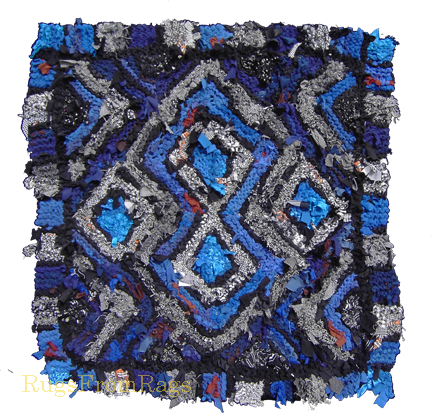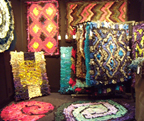Books that have influenced my art
I read. Much too much, I struggle with the gap between reading the book about a topic, and actually doing the thing the book is about. Left to my own dark-side inclinations, I’d almost always rather “know about (which comes by reading)” than “know (which can only come from doing).” It is good for my dancing that there are (not yet) any books about hooping.
Textiles
-
- Module Magic: Creative projects to knit one block at a time. Ginger Luters. XRX Books, NY, 2004. I wasn’t sure that I could hold the ideas of module knitting in my head after looking at all the books on the subject in the yarn store. Secondly, I wasn’t sure I wanted to–lots of stopping and starting and I like to knit long rows and be done with it. I bought this book because it appeared to offer the most ideas instead of project step-by-steps, and was proved right on both counts. I don’t like modular knitting, and I couldn’t remember the ideas. All of Kaffe Fassett‘s knitting books.
- Handpaint Country: A Knitter’s Journey. Cheryl Potter and Alexis Xenakis. XRX Books, NY, 2002. This book was published while I was away from knitting. It’s about hand-painted and dyed yarns; a few patterns but I bought it for the colored pictures and the writing about being in the textile business.
- Knitting in America: Patterns, Profiles, and Stories of America’s Leading Artisans. Melanie D. Falick and Chris Hartlove. Artisan, NY, 1996. Unexpectedly, this book was a key element in my leaving knitting for several years, during which time I turned to sculpture. Knitting had been my primary artistic outlet for years; the profiles convinced me that knitting would never support me in the business model I had in mind. (Still don’t know if sculpting, painting and jewelry will, but that’s another exercise.) top
- Designing Tessellations: The Secrets of Interlocking Patterns. Jinny Beyer. Contemporary Books, Chicago, 1999. All three of her books are useful; I didn’t need to buy Patchwork Patterns or Color Confidence for Quilters but it didn’t take but a quick review after an interlibrary loan to send me for my own copy of Tessellations. How to build patterns and then shift them to make infinitely variable designs using reasonably simple starting units. I have a whole series of rugs designed on a single square, and it would take a while for the casual observer to realize they are all knit to the same pattern.
- Bogolanfini Mud Cloth, Sam Hilu and Irwin Hershey. Shiffer, PA, 2005. I first saw this book in the gift shop at the National Textile Museum in Washington, DC, but didn’t have enough time to look closely enough to know if I had to own it. Another interlibrary loan allowed me to harvest the designs I can knit; they’ll keep me going for a few dozen more rugs. A tiny bit of text and the rest of the book is pictures, leaving you to your own interpretation. A wonderful way to print a book about textiles.
Becoming an Artist
-
- Mastery: interviews with 30 remarkable people. Joan Evelyn Ames. Rudra Press, 1997. What makes them different from us, and what practices and habits can you instill in yourself to improve your art?
- Mastery: The keys to success and long-term fulfillment. George Leonard. Plume Books, NY, 1991. About the “mysterious process during which what is at first difficult becomes progressively easier and more pleasurable through practice.”
- A Creative Companion: How to free your creative spirit. SARK. Celestial Arts, 1991. 30 minutes with this book will get me out of the worst slump.
- Art and Fear: observations on the perils (and rewards) of artmaking. David Bayles and Ted Orland. Capra Press, 1993. I try to read this book every time I’m on a plane and always come away with a better understanding of what it takes to make more and better art. See also Working in Series.
- The Language of the Goddess. Marija Gimbutas. Harper & Row, 1989. I recognized an unusual power in Sipentsi, which I carved from a drawing in one of Meehan’s books. That drawing referenced a culture much older than the Celts, and when I reviewed his references, I found Gimbutas. The book is a trove of ideas for carvings and paintings, drawing on very ancient symbols that lie at the core of our spiritual consciousness.
- Knotwork: The Secret Method of the Scribes. Aidan Meehan. Thames and Hudson, 1991. (And all of his other books.) Aidan has studied the original documents (his father is curator of the Book of Kells) and shares the history and construction methods used by the scribes who calligraphed the original Celtic scriptures.

Black and White and Blue Log Cabin hand knit rag rug - Celtic Art: The Methods of Construction. George Bain. Dover, 1973 edition. The first of the books that show how the knotwork was originally constructed. Meehan has developed, extended, and corrected Bain’s work. Bain remains a superb and affordable overview of the field.
- Other works: There are numerous books about Celtic art on the market. If you are looking for source material, be sure to review the copyright statements. Some are written so tightly there is little room allowed for inspiration.


